Theory question here. A narrow speaker can suffer from lesser amplitude of low frequencies in part due to the loss of a beneficial baffle step. What happens when a passive radiator is introduced to such a narrow speaker, on the rear or the side; does this help overcome the baffle step losses? My understanding is that frequencies below the baffle step turn omnidirectional, whereas those above are radiated in a forward plane. But when a PR is added, surely this means all the lower frequencies it helps with are radiated omnidirectionally?
An example of such a narrow speaker would be the Swiss Boenicke W5, which uses a side PR.
And my theoretical question would concern employing a PR to the rear of a speaker like a Gallo Micro or similar.
Thanks in advance.
An example of such a narrow speaker would be the Swiss Boenicke W5, which uses a side PR.
And my theoretical question would concern employing a PR to the rear of a speaker like a Gallo Micro or similar.
Thanks in advance.
A PR operates much lower and in very limited bandwidth and does nothing for baffle step. Baffle step has to be tamed much higher where the driver becomes omni as frequency is lowered
Below the baffle step it primarily doesn't make a difference whether the woofer or passive radiator are on the front or back, on the same side as each other or opposite sides.
Thank you for the replies. Essentially this is a question about maximizing low frequency response in an ultra small/narrow speaker through the use of an appropriate PR, with consideration given to how the lack of a sufficiently large baffle (of course in addition to small enclosure volume, which goes without saying) also typically disadvantages small designs. 'Taming' of the baffle step sort of addresses it as a negative (I know it's more complex than that, and I don't mean to misrepresent your point), but without a large baffle stepping up forward radiating low or lower-mid frequencies, part of the lower end is effectively lost. Can it be partially recouped with a PR (as seems to be done in many small Bluetooth speakers)?
To quote engineer Chris Brunhaver of PS Audio:
"What happens with a speaker is that radiation gets constrained, and each boundary, essentially, you gain a few db of output, so there’s this ‘boundary loading’ aspect to speakers. Let’s say you have something that’s a foot wide [as a baffle/front speaker box plane]. The frequencies that are above the ¼ wavelength the width of the baffle are reflected forward, pretty much. So there’s this shelving up of the response there. And then frequencies below that, transition to being omnidirectional. And that is that shelving up vs the omnidirectional sound as the radiation is constrained going forward [which] creates a ‘step’ in the response; you have high frequencies at one level, and then it steps down [lowers in amplitude]." Video interview.
To quote engineer Chris Brunhaver of PS Audio:
"What happens with a speaker is that radiation gets constrained, and each boundary, essentially, you gain a few db of output, so there’s this ‘boundary loading’ aspect to speakers. Let’s say you have something that’s a foot wide [as a baffle/front speaker box plane]. The frequencies that are above the ¼ wavelength the width of the baffle are reflected forward, pretty much. So there’s this shelving up of the response there. And then frequencies below that, transition to being omnidirectional. And that is that shelving up vs the omnidirectional sound as the radiation is constrained going forward [which] creates a ‘step’ in the response; you have high frequencies at one level, and then it steps down [lowers in amplitude]." Video interview.
Last edited:
It doubles the bass and lower midrange (really wants a second woofer that does midrange in place of the passive radiator) to compensate for the doubled radiation space. This means half the bass and lower midrange is going backward where it can bounce off the walls and cause comb filtering like issues.
Proper boundary loading asks that you design the speaker to work as a part of the wall, which is not something an ordinary speaker can do. You can find a place where the issues average out, and this is your best regular option.
Otherwise design for no baffle step, or listen outside where there are no walls. 😉
Proper boundary loading asks that you design the speaker to work as a part of the wall, which is not something an ordinary speaker can do. You can find a place where the issues average out, and this is your best regular option.
Otherwise design for no baffle step, or listen outside where there are no walls. 😉
As an example of the baffle's impact, I once did a bookshelf speaker using the smaller SEAS coaxial in two enclosures of identical volume, where one was a standard box with a normal flat baffle, and the other enclosure was entirely spherical and comparatively narrow in the frontal plane. When contrasting the two, the difference was far more dramatic than ever expected: the spherical enclosure had dramatically less bass. Ports lengths were identical, but mounted in different manners by necessity. No PR.
From this experiment, it was surmised how critical the baffle/baffle step can be.
From this experiment, it was surmised how critical the baffle/baffle step can be.
Last edited:
Many start by wanting substance in their baffle to make up the bass. After measuring and equalising the response to make the two the same, and seeing it can work either way, some then graduate to wanting that extra baffle support to instead prevent the midrange going behind the speaker.
"...equalising the response to make the two the same..."
Allen, sorry, to make two of what the same -- the response of two different speaker designs, and if so, what are the two designs?
You mention the smaller sphere having less bass. If you measured the standard box and the sphere and equalised them, they would become more similar. This is the idea behind baffle step compensation.
Another way to look at it is that you get the woofer to produce double the bass, it is similar to using two woofers.
Another way to look at it is that you get the woofer to produce double the bass, it is similar to using two woofers.
Ah, no, the sphere was not smaller than the box; the two enclosures were 100% identical in interior volume. Only the sphere, by nature of being a sphere behind a comparatively large driver, had much less of a baffle, or less of an effective baffle. Think of a tear drop. The rectilinear box had a larger flat plane as a baffle, and the sphere was just a narrow ball with a slim, immediately receding curved front around a driver. Not much of a baffle. It's not like the old Harry Olson diagrams for Bell Labs, if you're by chance familiar with them, that first tested spherical enclosure shapes back in the 1940s and 50s -- those front baffles were far larger relative to the driver. Here I'm talking about something like the Gallo Micro, or the SEAS small coaxial in an enclosure barely 2x that size. Small spherical baffles relative to the driver.You mention the smaller sphere having less bass. If you measured the standard box and the sphere and equalised them, they would become more similar. This is the idea behind baffle step compensation.
Another way to look at it is that you get the woofer to produce double the bass, it is similar to using two woofers.
By equalising, do you mean signal processing, pumping in more low frequency? This has some of its own disadvantages, of course, and is something I'd like to come onto after optimizing other elements.
Last edited:
Ah, yes I see. The point remains the same. Were you able to get good bass out of them after you found the best compensation EQ?
Not at all. I mean, yes, you can force more bass into the signal, but that's cheating. 🙂 We're talking about a dramatic difference, not minor. Which led me to PRs, as the compromise of pumping more low end signal or wiping out the upper end to balance it out, means dramatic loss in efficiency, loads of excursion required to get approximately the same effect, lower overall volume capability, and more. It's really too much compromise, hence why speakers are infrequently produced like this. And so began the foray into PRs used in such small spherical speakers, as another, alternative means of compensating. Then the portable small Bluetooth speaker revolution took off, with myriad types of small PRs never seen before, essentially demonstrating validity to this direction. I'm giving a long overview of the evolution over decades, but hopefully that helps.Ah, yes I see. The point remains the same. Were you able to get good bass out of them after you found the best compensation EQ?
If you want efficiency, use 2 woofers and you get +6dB response for +3dB power.
Are bluetooth speakers the same? some may use a passive radiator in place of a bandpass box port. I suppose the passive radiator could work out smaller?
Are bluetooth speakers the same? some may use a passive radiator in place of a bandpass box port. I suppose the passive radiator could work out smaller?
Hi,Ah, no, the sphere was not smaller than the box; the two enclosures were 100% identical in interior volume. Only the sphere, by nature of being a sphere behind a comparatively large driver, had much less of a baffle, or less of an effective baffle. Think of a tear drop. The rectilinear box had a larger flat plane as a baffle, and the sphere was just a narrow ball with a slim, immediately receding curved front around a driver. Not much of a baffle. It's not like the old Harry Olson diagrams for Bell Labs, if you're by chance familiar with them, that first tested spherical enclosure shapes back in the 1940s and 50s -- those front baffles were far larger relative to the driver. Here I'm talking about something like the Gallo Micro, or the SEAS small coaxial in an enclosure barely 2x that size. Small spherical baffles relative to the driver.
View attachment 1055679
By equalising, do you mean signal processing, pumping in more low frequency? This has some of its own disadvantages, of course, and is something I'd like to come onto after optimizing other elements.
unless your speakers were really big the baffle doesn't affect low frequencies so it has to be something else that made the difference, like resonance somewhere.
thought experiment: two speakers with similar size enclosures, volume the same, no resonances or other things just "perfect" situation for both, same tuning and all, but different shape. Both would play full space at some low enough frequency and half space at some high enough frequency. See, both would have same SPL at some low frequency and same SPL at some high frequency no matter the shape.
There is bafflestep here in between these two arbitrary high and low frequency which depends on the size of things. Roughly from 4x baffle size to 1x baffle size wavelengths. You can calculate what these are for your boxes. If the box dimensions were roughly 75cm then the bafflestep would be roughly between 100Hz-400Hz for example. If a speaker was 1.5meters then it would have some effect down to 50Hz. Or if it was about 35cm then the effect is roughly down to 250Hz.
If speaker dimensions change only little like a cube to sphere with same volume, the size is roughly the same and the bafflestep is roughly the same. What changes though, is diffraction. With sphere there is least amount and with rectangular baffle there is some, at least main diffraction hump that occurs about baffle size wavelengths. Again, this diffraction hump is not at bass. It would take room size baffle to have diffraction at bass frequencies.
Hence I suspect the difference was due to room modes affecting, either speaker or listening position changed. Or, if the speakers were big, man sized, then there might have been difference. Perhaps leakage or resonance or something higher up on midfrequencies changed the perceived sound but hard to believe it was bafflestep effect to bass.
Last edited:
Sorry for being a bit harsh, but what you wrote doesn't make sense. If the spherical box had less bass than the volume equivalent rectangular baffled box, then there are some options to explain this:As an example of the baffle's impact, I once did a bookshelf speaker using the smaller SEAS coaxial in two enclosures of identical volume, where one was a standard box with a normal flat baffle, and the other enclosure was entirely spherical and comparatively narrow in the frontal plane. When contrasting the two, the difference was far more dramatic than ever expected: the spherical enclosure had dramatically less bass. Ports lengths were identical, but mounted in different manners by necessity.
for some reasons the volume wasn't equivalent and/or the tuning was different (you need to measure FR and impedance)
or you use the term bass incorrectly and what you heard was simply the different baffle step profile (this should be easily audible)
Ralf
Says who? Makes as much sense as using a carburetor because EFI is 'cheating',I mean, yes, you can force more bass into the signal, but that's cheating.
Hi,
unless your speakers were really big the baffle doesn't affect low frequencies so it has to be something else that made the difference, like resonance somewhere.
thought experiment: two speakers with similar size enclosures, volume the same, no resonances or other things just "perfect" situation for both, same tuning and all, but different shape. Both would play full space at some low enough frequency and half space at some high enough frequency. See, both would have same SPL at some low frequency and same SPL at some high frequency no matter the shape.
There is bafflestep here in between these two arbitrary high and low frequency which depends on the size of things. Roughly from 4x baffle size to 1x baffle size wavelengths. You can calculate what these are for your boxes. If the box dimensions were roughly 75cm then the bafflestep would be roughly between 100Hz-400Hz for example. If a speaker was 1.5meters then it would have some effect down to 50Hz. Or if it was about 35cm then the effect is roughly down to 250Hz.
If speaker dimensions change only little like a cube to sphere with same volume, the size is roughly the same and the bafflestep is roughly the same. What changes though, is diffraction. With sphere there is least amount and with rectangular baffle there is some, at least main diffraction hump that occurs about baffle size wavelengths. Again, this diffraction hump is not at bass. It would take room size baffle to have diffraction at bass frequencies.
Hence I suspect the difference was due to room modes affecting, either speaker or listening position changed. Or, if the speakers were big, man sized, then there might have been difference. Perhaps leakage or resonance or something higher up on midfrequencies changed the perceived sound but hard to believe it was bafflestep effect to bass.
I'll augment the thought experiment with little ideal situation data. Flat piston on square baffle or roughly on a sphere. The size is about the same didn't mind the volume here. Attempt was to see if there is effect of baffle down to bass.
Its ~8" ideal driver on 35cm and 70cm square baffle without corner radius and 35cm and 70cm diameter circular baffle with big roundover approximating a sphere. Top most green line on the graph is listening window, so basically the on axis response. Blue is power response.
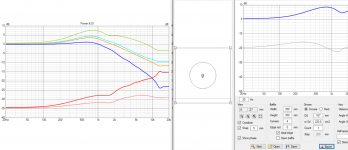
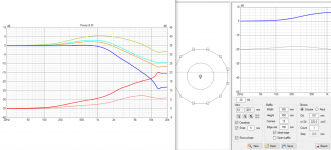
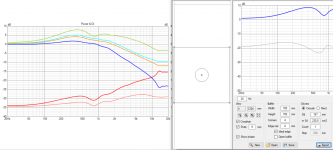
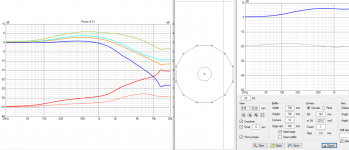
There is some effect lower than 4x wavelength, especially with square baffle, so the effect extends somewhat to bass with these baffle sizes. More over the sphere has less boost on bass, at least in the simulation, as lucadelcarlo suggests. This is about 1db difference and not sure if as audible as slight positional change in room though. Could be simulation thing as well. Still a bit of a surprise, never looked too closely into the bass region with diffraction sims and this makes the claim plausible in my view that sphere has less bass than similar size flat baffle.
While there might be audible effect to bass between two similar sized small speaker due to bafflestep, most of the change in response due to the shape happens due to edge diffraction and at mid range frequencies and these surely are audible being several more decibels difference, and to various directions. Here in these examples the main diffraction hump is around <1kHz and <500hz. To get the diffraction to very low frequency a huge baffle would be needed, <250Hz diffraction hump would happen ~140cm x 140cm baffle if continuing these sims.
Square baffle was selected to emphasize the diffraction hump. If baffle had different aspect ratio the bafflestep and diffraction gets "stretched" between the dimensions as well but it doesn't get lower than the longest dimension. Many people have +1m tall speakers which are quite narrow however. Here is 140cm tall, 35cm wide baffle for comparison. This is closer to 70cm sphere in response than the square, it has less effect on bass than square baffle with maximized diffraction.
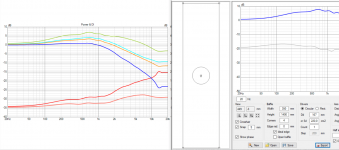
Anyway, bass is about the easiest thing to tackle with any speaker system so I wouldn't discount the sphere, quite contrary. Just use enough big enough drivers and pour in some power and call it a day. Due to long wavelength there is very little audio quality problems other than getting enough, and distributed nicely in room. Room affects the response in bass much more than any baffle size that fits inside that room.
Last edited:
Thank you @tmuikku for that detailed response inclusive sims. Attached here is the application note from SEAS for the enclosure design that was used as reference, and constructed. Also, using the identical driver, is the spherical teardrop enclosure. The reference was built from 19mm-thick MDF as instructed, and its lengthy wood port consumes internal volume considerably, while the biomorphic enclosure is a very rigid material with a circular port tuned similarly. SEAS x-over design was implemented, but outside the enclosures. Both remaining internal volumes are matched. That the perceived sound from the listening position differs due to diffraction, baffle step, and factors in combination was audible, though, less so with the HF unit shut off. Describing it as less bass was shorthand; it seemed less full, as if something were lost in the mid-to-lower end. Photo shows them atop table and a base that wasn't a 2nd chamber or enclosure. Room: old English townhouse small living room, reflective, wood floors, open to hall and kitchen.
Attachments
Last edited:
Yes, PRs in very small Bluetooth speakers are quite common, which isn’t the case with bandpass designs in them due to size, as surmised, and the fact that these small units rely on FR drivers.If you want efficiency, use 2 woofers and you get +6dB response for +3dB power.
Are bluetooth speakers the same? some may use a passive radiator in place of a bandpass box port. I suppose the passive radiator could work out smaller?
If going with the car analogy, I see it fitting in the reverse way – it's actually the added efficiency of EFI resembling efficiency in a speaker & enclosure design that doesn't require additional signal and boosting to perform as desired. The less efficient carburetor/speaker design requiring more fuel/low-end compensation, is acceptable, but only up to a point, particularly with a small driver, and then it becomes less than optimal. When excursion and thermal limits are reached sooner, that's a compromise. We're talking about very small spherical speakers here, as small as 10.5 cm to ~16 cm in diameter, 0.5l to 2.5l internal volumes, wherein maximizing their capabilities runs up against these issues in a more pointed manner than in a larger, more relaxed speaker. Think of small production Bluetooth units like the Amazon Echo or Dot or Alexa, Google HomePod Mini, or Ultimate Ears Wonderboom, or, of course, the non-Bluetooth passive Micro. It’s nowhere close to a traditional box speaker, NS10s, or even most bookshelf designs. This hasn’t been the realm most hobbyist or advanced speaker builders work in, but it is the focus and means by which so many people take in music now – powered, all-in-one, compact form factors with DSP, PRs, and other elements to maximize performance in a given small size. Though the DIY market lacks the production capability or research teams to make dramatic changes and advances in maximizing sound from very small footprint devices, there's certainly R&D there that’s changed the audio market landscape for common people.
- Home
- Loudspeakers
- Multi-Way
- Passive radiator on rear of narrow speaker; baffle step considerations



